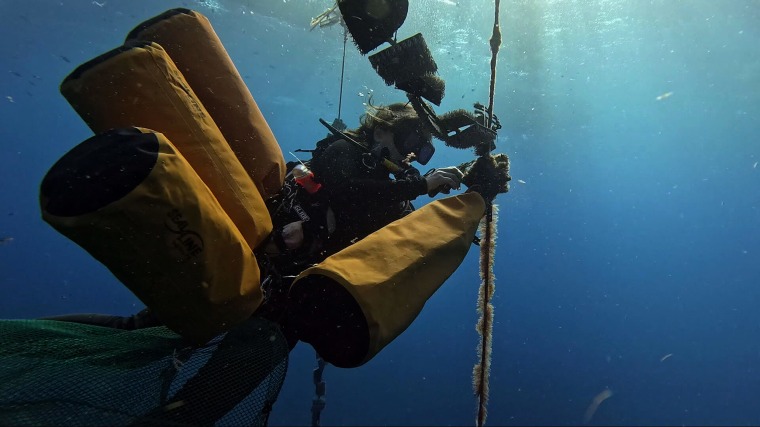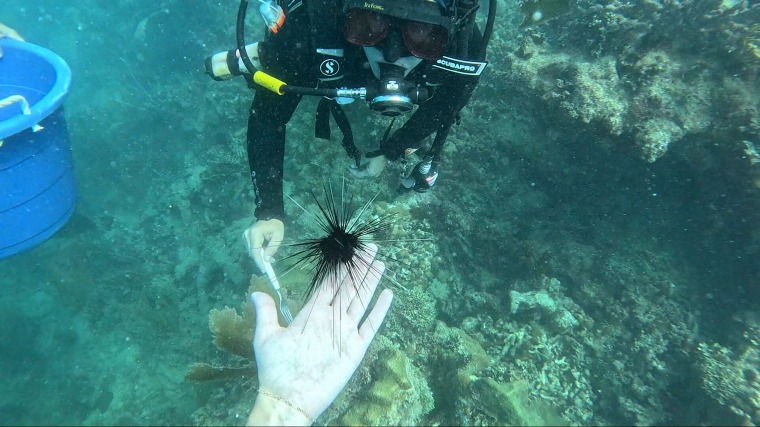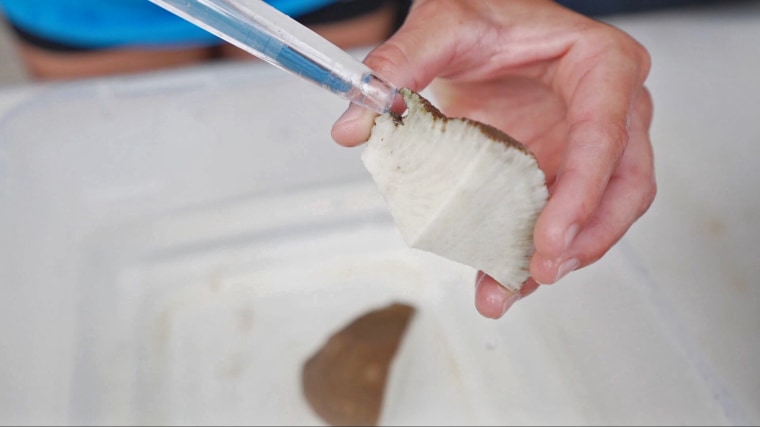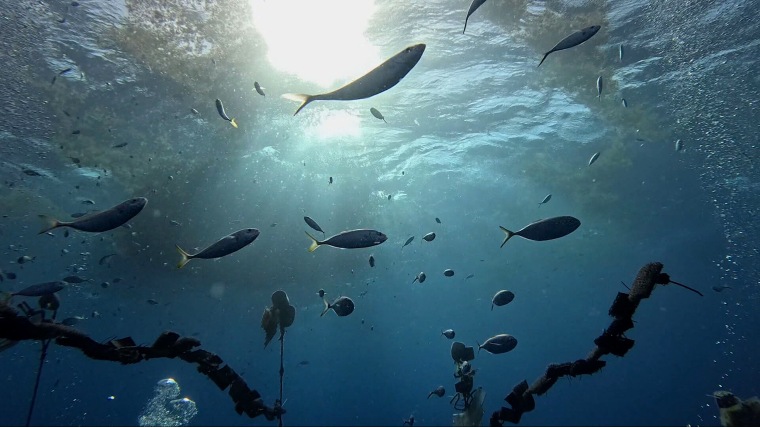There has never been a worse time to be coral in recent history.
More than a quarter of the world’s oceans have experienced heat stress severe enough to bleach corals, according to Derek Manzello, an ocean-atmosphere ecologist. Coral Reef Watch Management Program.
“There was this kind of crisis last year where people were like, ‘Oh, my God, are we seeing the end now?'” Manzello said. In fact, the oceans are getting warmer so that it is difficult for them to continue living.
In April, NOAA announced the fourth global blackout event – which continues today and is growing.
“This is the worst event that has ever affected the Caribbean, Florida as well as the South Atlantic and Brazil,” Manzello said, adding that “99.9% of all reef areas in the Atlantic Ocean – the Atlantic and the North and South. – he had heat stress last year, which is crazy. That’s never happened before.”
Coral reefs are home to about a quarter of all marine life, and are nature’s protection against storms. But they are sensitive to heat, and scientists have long worried that they will be among the first ecosystems lost to climate change.
So in disaster-hit areas like Florida and Puerto Rico, scientists are trying new ways to restore reefs and make corals more resilient to warmer seas. That effort could buy time for reefs to recover and for humans to reduce greenhouse gas emissions.
Some of the recent breakthroughs, including reports that corals can withstand extreme temperatures, have bolstered researchers’ hopes.
“We still have time to right the ship,” Manzello said.

In July, divers and a team of researchers descended into tropical waters off southwestern Puerto Rico, near the reef of La Parguera Marine Preserve. Schools of bar jack fish swam by, the sun’s rays beating off their silver sides. The barracuda passed by, scaring the small fish and surprising the divers, who were working with the Institute for Socio-Ecological Research (ISER Caribe).
The team was installing hanging cages for the baby Diadema antillarum – an organism that can help corals grow by reducing harmful algae.
Nearby, a group of coral fragments were beginning to take root; the researchers had grown them to survive in the soil before replanting them on the rock. Eventually, they plan to put 22,000 such pieces.
This reef boasted a variety of corals but was showing signs of damage. The colors were muted, and the “chatter” often heard in a healthy rock – sounding like it was still to the human ear – was absent. Another worrisome sign: The water was about 86 degrees Fahrenheit, far from the temperature at which scientists worry about bleaching.
Corals are sessile creatures, meaning they are rooted in one place. They depend on symbiotic, photosynthetic algae that live within their cells, producing nutrients and giving them their commercial color.
When temperatures rise, symbiotic algae can go haywire, producing harmful chemicals and less food, stressing corals and forcing them to excrete algae. This process leaves the corals looking like bones and white and puts them at risk of death.
When corals are bleached, they are under extreme stress. So any other impacts, like water quality or UV radiation or sedimentation from the soil, all that pressure could kill these corals,” said Stacey Williams, executive director of ISER Caribe.
The group is working to restore 5 hectares of coral reefs in Puerto Rico by planting patches across six reefs and reintroducing long-lived sea urchins to the ecosystem.
Urchins feed on harmful algae that live in warm waters and can harm corals.
“They’re like goats or manatees,” said Williams.
When corals die or darken, the organisms that live on them can become covered in such algae.
“If the soil is already covered with algae, the coral larvae will not live there,” said Juan Torres-Pérez, a coral expert and NASA researcher, who grew up and studied in Puerto Rico.
In the 1980s, long-spined sea urchins died out across Puerto Rican reefs. Now, they struggle to live in the past of La Parguera’s life. So to strengthen the urchins, researchers at ISER Caribe have suspended pieces of material such as AstroTurf in several rows 25 meters long, supported on the ground by cement bricks.
Materials such as grass provide a home for baby urchins to cling to. Divers collect pods and bring urchins to the nursery to grow. Then, once the urchins reach adult size, researchers place them in coral reefs that need extra support.

It is one of many environmental projects testing new ways to help corals survive.
In Florida, scientists from the University of Miami for the first time imported corals to the US that appeared in the warm waters of Honduras. Scientists hope to breed corals from other countries with Florida natives to produce corals that are more heat tolerant.
Andrew Baker, who runs the Coral Reef Futures Lab at the University of Rosenstiel School of Marine, Atmospheric, and Earth Science, spent 15 hours flying with corals in a cargo plane.
“We need a way to fail fast and stay open to new ideas,” Baker said, referring to common ideas for the development of engineering and business technologies. “The quality of nature is rapidly declining in the toilet due to climate change. The more we act to speed up the response of these ecosystems to planetary change, the worse the impact of inaction will be. ”
Other efforts are beginning to show promise. In a study published Wednesday in the journal PLOS ONE, scientists reported that small, lab-grown corals for restoration projects in several parts of the Caribbean survived the hottest ocean temperatures in 2023. corals in the areas the same.

Scientists have been warning about the fate of corals for years. In 2018, the Intergovernmental Panel on Climate Change estimated that 70% to 90% are at risk of “long-term damage” if global temperatures rise by 1.5 degrees Celsius and that 99% could be at risk by 2 degrees of heat.
Last year, the hottest year ever recorded on Earth, was 1.48 degrees warmer than pre-industrial times.
Manzello said scientists thought coral reefs had a long way to go — perhaps until 2040 or 2050 — before conditions turned so dire.
Manzello said: “Last year everyone was scared. “The Caribbean last year was unreal, and nobody expected things to be so hot.”
Expensive, time-consuming coral restoration projects are unlikely to keep up with losses due to climate change. But creating healthy pockets of coral can at least give reefs a chance to bounce back in the future.
“You’re going to have to pick and choose where you put your efforts,” Manzello said. “But the bottom line is this: For some coral species, especially in places like Florida and the Caribbean, aggressive intervention and regeneration will be the only things standing between those species finally becoming extinct.
Baker compared Florida’s reef systems to a jigsaw puzzle.
“We probably lost 80, 90% of the coral. “However, we have not lost any coral species,” said Baker. “We’ve messed up that jigsaw puzzle and broken it into pieces, but we haven’t lost the pieces yet.”
Meanwhile, forecasters say the El Niño weather pattern that contributed to record ocean temperatures since 2023 is over. The change could help cool the oceans a bit — at least temporarily.

Evan Bush reports from Seattle and Maura Barrett from La Parguera Marine Preserve, Puerto Rico.
#coral #reefs #face #unprecedented #heat #scientists #experimenting #ways #protect